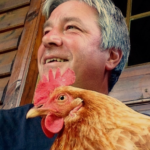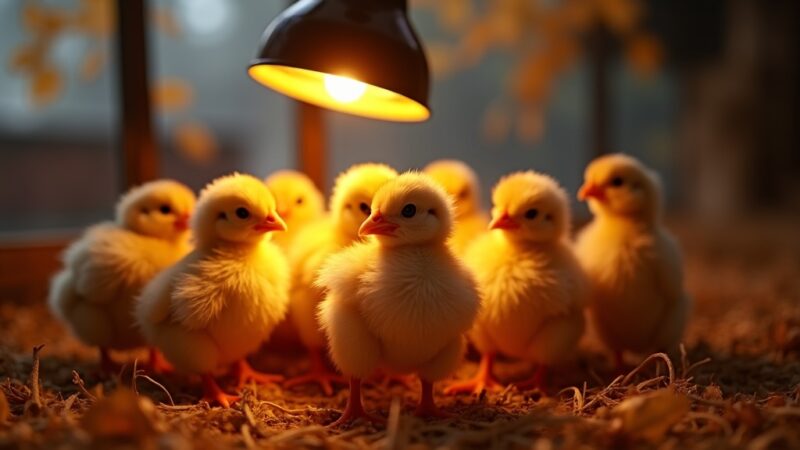
Hatching chicks late in the season can put you on edge as cooler evenings roll in. These little guys start off vulnerable, especially when autumn’s chill can nip at their health and energy. I’ve handled plenty of late-season hatches and can tell you that a few smart steps really make a big difference for your flock’s comfort and survival.
If you want to keep hatched-late chicks warm, healthy, and thriving as temperatures drop, I’ve gathered up what works best. From knowing how cold is too cold to setting up the right heat source, it’s all here to help your young chicks beat the autumn cold safely and come out strong.
No worries, though – it’s all about making a warm place for them to acclimate fully.
Understanding Young Chicks’ Needs in Cooler Weather
Chicks hatched later in the year miss out on the reliable warmth their spring siblings enjoy. When they first hatch, they can’t control their body temperature on their own for about six weeks, or until they are fully feathered.
Getting chilled leads to weak immune systems, slow growth, or even sudden losses, which means staying ahead of the cold is really important.
How Cold is Too Cold for Day-Old Chicks?
- Chicks younger than a week old should never be exposed to air below 32°C (90°F) without a heat source.
- Any temp below 25°C (77°F), even for a short while, can cause chicks to pile up, get stressed, or catch a chill.
- Wind, dampness, and drafts make cold temperatures even tougher for them to handle.
You’ll spot signs quickly if chicks are too cold. They’ll huddle tightly, peep loudly, or move slowly. Always keep an eye out for these behavior clues, primarily through autumn nights.
Setting Up the Brooder
A reliable brooder setup is your best friend for chilly autumn nights with late-season chicks. Paying extra attention to insulation and warmth goes a long way when the air cools down.
Key Brooder Setup Tips
- Pick a sheltered spot: Garages, sheds, and laundry rooms work well because you can block drafts, keep out wind, and avoid sudden drops in temperature. Keep in mind that the little critters make dust like they’re magical. I made the mistake of using a three-season room as a late-winter temporary coop. Wow! Never again!
- Size matters: Don’t use a brooder that’s too big; a snug space keeps heat in, making it easier for chicks to stay warm together without cold corners.
- Floor bedding: A thick layer of pine shavings or compressed straw insulates from chilly ground. Steer clear of paper towels or newspaper, which draw a lot of moisture and don’t provide much warmth at all.
- Cover and draft guards: Block drafts using cardboard barriers or towels tucked around brooder edges. A wire cover not only keeps curious pets out but also traps some warmth inside.
The goal is to make a cozy, safe, and easily cleaned space where the temperature stays stable, even if your local weather is unpredictable as fall sets in.
Heat Sources
The right temperature is key for thriving chicks. They need steady warmth, especially at night when the autumn air gets biting cold. Over the years, I’ve tried a variety of heat setups and found out that safety, reliability, and adjustability really matter for late-season chicks.
I have one heat lamp that I use as a last resort. Heat plates are the way to go. I
Best Heat Sources for Autumn Chicks
- Heat lamps (use with caution): A red or infrared bulb set at a safe height works if it’s properly clamped and secured. Always opt for a ceramic socket and keep the fixture from falling in (use a chain, not a string). Put the bed away from the lamp to avoid fire risk. I recommend an inline thermometer placed at chick height to track hot or cool spots.
- Brooder plates: These low-wattage warming plates let chicks gather beneath like with a mother hen. They’re safer, use less energy, and help prevent the whole brooder from overheating.
- Space heaters for room warmth: In icebox garages or outbuildings, a small oil-filled radiator can knock off the chill. These should only be used alongside a focused heat source for the chicks—not as a main heat supply. These heaters will make your electric bill chirp louder, so be aware of that. I use an infrared heater with a fan and thermostatic control.
Ideal Temperatures for Chicks After Hatching
- Days 1-7: 32°C to 35°C (90–95°F)
- Lower by roughly 2.5°C (5°F) each week as the chicks grow and feather out (six weeks)
- Pay attention to chick behavior. If they cluster right under the lamp and chirp loudly, they’re probably too cold and/or there is a draft; if they spread out, avoid the lamp or pant, they’re too hot
Don’t forget a reliable digital thermometer at chick level to double-check that the temperature stays consistent 24/7. This detail matters a lot on those unpredictable autumn nights.
Feeding and Hydration
External warmth is only part of the challenge. Hatched-late chicks need a little extra help in their diets to keep their energy and body heat as the autumn wind sets in. I always check waterers and feeders several times a day, once the air is chilly. Nothing will chill a chick faster than a soaked brooder or a gusty draft where they can’t dry off or warm back up quickly.
Nutrition Tips
- Starter crumble with at least 18–20 percent protein ensures rapid growth and helps keep them toasty from the inside.
- Offer slightly warm water (not hot) overnight and in the mornings. Cool water on cold mornings can drop a chick’s core temperature quickly. Newly hatched chicks should always start with warm water to keep their little cores warm.
- Sprinkle a pinch of chickgrit if you’re introducing treats. Extras should be minimal for very young chicks who rely on complete feed.
Chicks generate a lot of their own warmth by digesting feed, so keeping bowls filled and clean makes a major difference. Don’t skimp on this routine as the season cools.
Extra Tips for Chilly Autumn Nights

When autumn’s chill comes on fast, a few extra tricks help keep late-season chicks healthy and resilient:
- Double-check run-through: Most issues like power outages or leaks happen overnight. Always do a visual run-through before turning in.
- Watch for surprise drafts: Anything from a cracked window to a sneaky barn cat could cool your setup in minutes.
- Blanket insulation: Draping a heavy towel (never covering the heat directly) over the brooder traps heat well. This is especially handy when outside temps dip under 10°C (50°F).
- Frequent peeks: I always do morning and before-bed checks to spot slow-moving, hunched, or chilly chicks early.
Common Questions about Keeping Autumn Chicks Warm
What if the power goes out and my heat source fails?
Having a backup generator or a plan for frequent outages is wise if you’re in a rural area. Wrapping chicks loosely in towels if things get bad. Use blankets to hold in warmth (without smothering) and keep chicks together to share body heat. If you have a wood stove, you can carefully move the chicks into the vicinity of the stove. Don’t worry, they will let you know when the fire is dying down at 2 AM.
Can mother hens keep autumn chicks warm?
If you’re using a broody hen, she handles most of the warming herself as long as she’s healthy. The coop must be free of drafts and dry. Provide a supplemental safe heat lamp only when temperatures are especially low at night.
When can chicks go outdoors in autumn?
Chicks need full feathers (usually between 5–7 weeks old, depending on the breed) before spending time outside in cool weather. Wait for days with steady temperatures above 21°C (70°F), and always move them out slowly so they can get used to the change.
Keeping Chicks Alive and Thriving Through Autumn
Raising late-hatched chicks as the leaves fall means being extra watchful when temperatures drop. With a properly insulated brooder, safe heat, and constant attention to what your chicks need, autumn birds can grow as big and strong as any hatched in spring. The key to success is staying sharp – see cold signs early and act fast.
What’s the bottom line? Keep them warm, fed, and watered. Sounds a lot like us.
Take care, Catch you next time.
Dave

Chickenmethod.com

